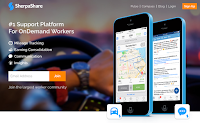IS THE SMARTPHONE MICROLABOR ECONOMY A MODERN GOLD RUSH?
-----------------------------------------------------------------------------------------------------------
I am wrapping up my project for the ICFJ-S&P Global Financial Data Journalism Program. I am honored to have won the first prize fellowship to expand my dig into the LA gig economy that started at LA Weekly. My piece on two LA millenials making the gig economy more navigable runs on Thrillist Los Angeles on Friday; the rest of the project will run here, as a series:
Wed. Aug. 31 Mileage, mapping, and weather applications
Wed. Sept. 7 Gig economy accounting
Wed. Sept. 14 Out-amenitize the competition
Wed. Sept. 21 Lawyer up
Wed. Sept. 28 Side hustle your side hustle
Wed. Oct. 5 Cash out early
Wed. Oct. 12 Monetize your mistakes
Wed. Oct. 19 Find your people
-----------------------------------------------------------------------------------------------------------
The growing independent contractor workforce that is staffing smartphone application-based services like Uber and TaskRabbit created a new market for products that purport to make these microlabor contractors’ gigs safer, easier, and more profitable.
 Among other tools for efficiency, ride hail drivers can track mileage to write off as much tax liability as possible using MileIQ, Postmates takeout deliverers can integrate all their information on SherpaShare, and all gig workers can use accounting platforms like the self-employed version of QuickBooks.
Among other tools for efficiency, ride hail drivers can track mileage to write off as much tax liability as possible using MileIQ, Postmates takeout deliverers can integrate all their information on SherpaShare, and all gig workers can use accounting platforms like the self-employed version of QuickBooks.In tracking expenses and saving time, they are, in effect, earning. But who is really profiting?
Whose windfall?
In the middle of the 19th century, another dash for seemingly easy cash without any industry-specific past experience mostly produced a boom for the vendors hovering around migrants panning California’s rivers and streams. If not the new California Gold Rush, gig work could just be this decade’s tech-fueled promise of extra income doing something you already do.
Last decade, in the aughts, you could troll chat rooms and message boards as an affiliate marketer and net some green, because you pretty much live online anyways. It’s effortless. At least that was the rumor.
Before that, in the 1990s, it was multi-level marketing like Amway, ACN, and Excel, allowing you to earn on person-to-person selling and recruitment bonuses when you already talk household products and compare phone companies with your friends. That’s the hardware store scene in Garden State, when
the high school classmate suddenly veers into a rehearsed pitch about a great opportunity in need of smart people.
Had Andrew Largeman not heeded his friend’s advice to withhold his phone number, he may have escalated to the next level of the organization, where he would be told that you have to have money to make money.
Now that we’re in the two thousand-teens, and you know you check your smartphone every two minutes, you might as well pick up some earnings opportunity along with your text messages. They’re looking for smart people like you.
But to make money, you’re going to front some money. Accept the costs that come with the opportunity.
It’s hard to tell exactly how well costs balance with opportunity for gig workers when you don’t know who they are or where they started. They could fall into multiple categories tabulated by the Bureau of Labor Statistics.
Available Census data is not recent or categorized enough to discern whether shifts in average wages could be attributed to on-demand labor opportunities.
Sudden entrepreneurs
They're not just in a different field of employment; they're learning to be self-employed. And when you’re newly self-employed, you’re really a new business owner, with the avalanche of choices and dearth of experience in fielding your way through the business-to-business marketing, financial planning, and self-implemented structure that evade the many first businesses that fail.
Uber commercials make it seem that this new business ownership is a kind of freedom, more time to do what you care about. In reality, you have less time because you're grappling with decisions and tasks you never anticipated.
That where this new sector of services-for-services, a kind of app aftermarket, comes in. If you want to save a little more each shift or save better over the year, out-amenitize competing ride hail drivers, shield yourself from liability, earn passive income on each drive, bring other people in to the workforce for bonuses, cash out your earnings early, or make a business out of monitoring all of the above, a new crop of companies will tell you it’s all just a click away.
The original gig economy
This massive and congested metropolis is the unofficial national lab for this new sector of services-for-services, a kind of app aftermarket, because on-demand labor has a long history in LA. It’s a function of two of our most famous occupants: broke performers and hellish traffic.
Long before Uber modeled the technology for you to farm out any service with a couple swipes and a pin on a map, this was the home of the side job, all the Hollywood hopefuls doing what they must between auditions and gigs.
Now that there is an Uber for everything - dog walking (Wag!), errands (TaskRabbit), grocery shopping (InstaCart), takeout (DoorDash), every restaurant and retail random (PostMates), laundry (Washio) - all of us pigeonholed about town can patronize this microlabor to get through our time-crunched weeks. We broadened the demand for this army of roaming independent contractors, now composed not only of floundering creatives, but undermployed Millenials in hustle mode as well as Angelenos of every stripe.
Next: Mileage, mapping, and weather applications Aug. 31
-----------------------------------------------------------------------------------------
Note: This was first posted on Wed. Aug. 24 at 7:38 a.m., then edited and reposted at 11:45 p.m.
-----------------------------------------------------------------------------------------
Support for this research comes from the International Center for Journalists, where I am a 2016 S&P Global Financial Data Journalism Fellow.



Comments
Post a Comment